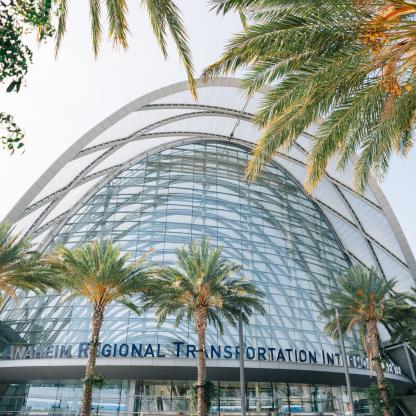Conservation program helps bolster wild population of critically endangered southern mountain yellow-legged frogs
September 7, 2023, Long Beach, CA—Approximately one hundred and seventy critically endangered southern mountain yellow-legged frogs were released into their wild habitat in the Southern California mountains on August 29 and 30, 2023. Most of the tadpoles were hatched at the Los Angeles Zoo and then traveled to the Aquarium of the Pacific and Santa Ana Zoo to be raised into frogs. Around ninety of the frogs were raised at the Aquarium of the Pacific and fifty were raised at the Santa Ana Zoo. The remaining frogs were from a group of tadpoles that were rescued from the Bobcat Fire that the Aquarium received in 2021.
“Releases of endangered species are exciting moments, but what makes this release extra special is that these frogs are from a genetically under-represented population, which can help to further increase the chances of this species’ survival,” said Brett Long, the Aquarium’s director of mammals and birds. After the Bobcat Fire in 2020 threatened the cold-water streams where this species lives, government wildlife agencies rescued mountain yellow-legged frog tadpoles from these areas and placed them with local institutions like the Aquarium of the Pacific and other partner facilities such as the Los Angeles Zoo.
Since 2007, when the breeding colony was established at the Los Angeles Zoo, nearly 6,000 zoo-bred offspring have been released into the San Gabriel Mountains and surrounding habitats. This includes some tadpoles hatched at the Los Angeles Zoo and raised into frogs at the Aquarium of the Pacific and Santa Ana Zoo. The program is designed to bolster populations in the wild in an effort to save this species from extinction.
“This release is momentous for the L.A. Zoo as it marks another key milestone for our southern mountain yellow-legged frog breeding program,” said Ian Recchio, L.A. Zoo curator of reptiles and amphibians. “We are proud to be part of the continuing recovery effort with U.S. Geological Survey (USGS) and partners. We hope Angelenos will see this effort in their own backyard and think about actions they can take to help conserve wildlife.”
After this release, the Aquarium is continuing to care for more tadpoles behind the scenes to raise them from that vulnerable stage up to froglets for future release. The Santa Ana Zoo currently cares for forty-one juvenile frogs. Last year, 188 of these amphibians raised at the Aquarium and twenty-five from the Santa Ana Zoo were released to the wild.
Several organizations have partnered in the effort to raise and release the frogs. Scientists and officials from USGS and California Department of Fish and Wildlife monitor wild populations and oversee releases; and partners include institutions like the Los Angeles Zoo that breed and hatch frogs and like the Aquarium of the Pacific and Santa Ana Zoo that raise the tadpoles until they are ready to be released.
“It’s been an honor working with our recovery program partners to help ensure the survival of the mountain yellow-legged frog. They used to be one of the most common amphibians in our mountains, and we hope to see them thriving in their natural habitat again one day. Our goal is to establish at least twenty stable populations in the wild with at least fifty frogs each to ensure this species continues on for the next one hundred years. This recent release was one more step towards making that happen,” said Amber Suto, education specialist and key member of the Santa Ana Zoo’s recovery program.
Southern mountain yellow-legged frogs (Rana muscosa) are native to California’s mountainous regions and depend on habitats in the San Gabriel, San Bernardino, and San Jacinto Mountains. This species is a medium-sized amphibian, measuring between 1.5 to 3.25 inches on average. Adult frogs are a mix of brown and yellow coloring but can also be grey, red, or greenish brown, usually with dark spots or splotches. These spots can look like lichen or moss and make the frog appear camouflaged. The belly and underside of the back legs, and sometimes front legs, are yellow or light orange, which lends itself to the frog’s common name, “yellow-legged.” To help these frogs recover, you can support this conservation effort by staying on marked trails and paths, respecting signs announcing off-limits areas when visiting local mountains, and reducing your carbon footprint.
The public can view the southern mountain yellow-legged frog at the L.A. Zoo’s seasonal habitat inside its Living Amphibian, Invertebrate, and Reptile exhibit (LAIR). The habitat is open to the public during regular Zoo hours between May and November, after which the frogs move to the Zoo’s bio-secure amphibian breeding facility for the breeding season.
About the Aquarium of the Pacific
The nonprofit Aquarium of the Pacific is a community gathering place where diversity and the arts are celebrated and where important challenges facing our planet are explored. The Aquarium is dedicated to conserving and building nature and nature's services by building the interactions between and among peoples. Home to more than 12,000 animals, Aquarium exhibits include the Southern California Gallery, Babies!, Coral Reefs: Nature’s Underwater Cities, Pacific Visions, and Shark Lagoon. Beyond its animal exhibits, the Aquarium offers educational programs for people of all ages, including First Wednesdays featuring guest speakers. The Aquarium offers memberships with unlimited FREE admission for 12 months and other special benefits. To make a donation to help support the Aquarium, please visit Pacific.to/donate. To visit, advance reservations are required for everyone and can be made at aquariumofpacific.org or by calling (562) 590-3100. The Aquarium of the Pacific is located at 100 Aquarium Way, Long Beach, CA 90802.
About the Los Angeles Zoo
Accredited by the Association of Zoos and Aquariums (AZA), the landmark Los Angeles Zoo and Botanical Gardens, drawing more than 1.8 million visitors each year, is home to a diverse collection of nearly 2,000 animals representing 290 different species, 66 of which are endangered. Its lush grounds on 133 acres feature various plant species from around the world and California including many rare and endangered species. The Zoo is located in Griffith Park at the junction of the Ventura (134) and Golden State (5) freeways. Admission is $22 for adults and $17 for children ages 2 to 12. For information, call (323) 644-4200 or visit the L.A. Zoo website at www.lazoo.org.
About the Santa Ana Zoo
Through fun, learning, and adventure, the Santa Ana Zoo empowers the community to save wildlife and wild spaces. Featuring small primates, giant anteaters, ocelots, camels, and birds, the zoo is also a botanical garden. Admission is $13, or $10 for seniors and children ages 3 to 12. Address: 1801 E Chestnut Ave. Santa Ana, CA 92701. Phone: 714-647-6575. Part of the City of Santa Ana, the zoo is also supported by its non-profit organization, Friends of Santa Ana Zoo. For information, visit https://linktr.ee/TheSantaAnaZoo














